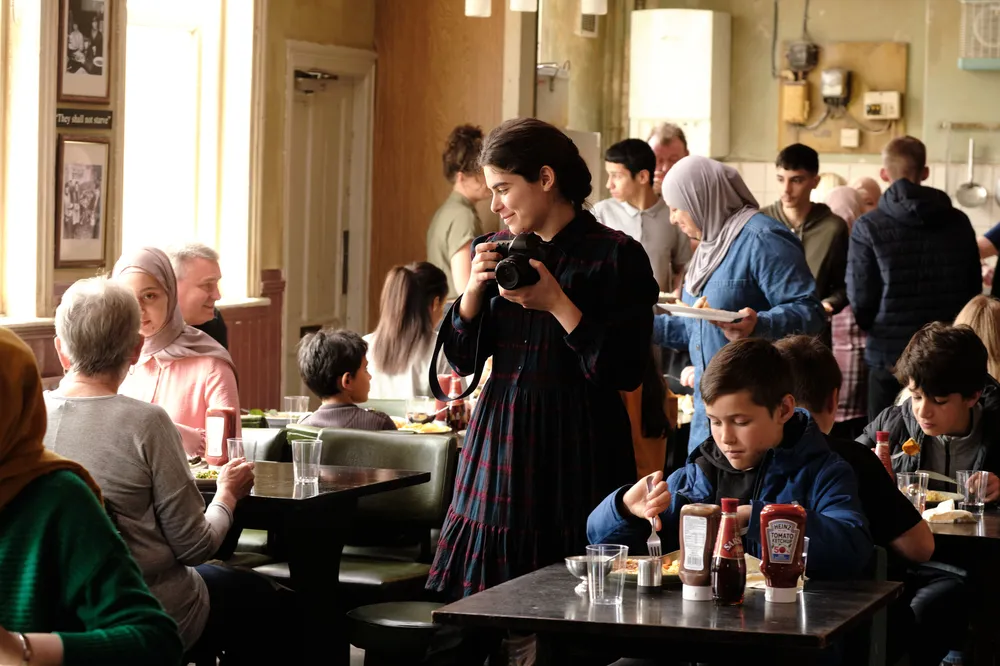In a film that’s both heartwarming and extremely difficult to watch, The Old Oak highlights the unique relationships and dynamics between locals and newly resettled Syrian refugees. It reveals how a community comes together to serve a common good by providing free meals to the townspeople.
The Old Oak screened at the Vancouver International Film Festival (VIFF) which ran from September 28–October 8. Set in 2016, the film by Ken Loach confronts issues of food insecurity, poverty, labour rights and refugee settlement in the unspoken subcontext of the “Brexit” movement in the United Kingdom.
The fictional drama follows a struggling pub owner named Mr. TJ Ballantyne in an old town in Northern England still suffering from the economic consequences of a local mine closure. When several Syrian refugee families suddenly arrive, this sparks harsh xenophobic and racist backlash from many locals who are barely making ends meet. But TJ steps up to help the families as best he can, forming a friendship with the young English-speaking Yara.
Along with other supportive locals, the two set out to give back to those in need. At TJ’s pub, the Old Oak, they begin offering weekly free meals and conversation to families facing food insecurity, fostering a space where newcomers and locals alike form a sense of community, solidarity and belonging that transcends ethnic and religious differences.
But with the Old Oak remaining as one of the town’s last gathering places, not all locals are happy about how the pub space is being used, so they set out to secretly sabotage the charity.
The Old Oak is an eye-opening film for those not used to the overt racism that exists in many rural communities across Europe and North America that received an influx of Syrian refugees. Canada has welcomed nearly 73,000 refugees, with Vancouver becoming home to roughly 2,600 Syrian immigrants, and it hasn’t always been easy.
The film depicts uncomfortable moments where expletives and coarse language are directed at Syrians of all ages. For example, in a difficult scene where local schoolboys target a young Syrian boy, they film him being bullied and beaten. This video is sent to older locals who watch it in TJ’s pub, defending the schoolboys’ harassment and putting the blame on the victim. Unsettling, racist scenes much like this are scattered throughout the film.
But crude confrontation, rejection and flat-out racism are not every character’s sentiment. The film does a good job of balancing different perspectives, exploring how the locals with differing viewpoints interact with one another and looking into the nuances of why some locals had such harsh negative reactions.
Viewers observe these different perspectives through TJ’s relationships and backstories involving loss and depression. As we get to know TJ and watch the development of his friendship with Yara, he becomes a very likeable main character — by no means does the film portray TJ as a brave saviour, rather it highlights his learned confidence and quiet courage to stand up for all townspeople.
TJ’s care for the townspeople means transforming the back room of his pub into a communal meal space. This event is the culminating point of the film where the townspeople start to unite: Sharing food becomes a way to look out for and learn from one another.
Though it is nuanced in its portrayal of the characters’ backstories, the film is obvious about what message it wants viewers to take away from it. Directness and simplicity are not necessarily faults, but if you’re looking for a movie that is highly complex and leaves you thinking about it for days after watching, this is probably not it.
Above all, The Old Oak leaves viewers with a better understanding of how communities can find ways to come together to celebrate their differences, showing that food can be a powerful point of connection regardless of personal beliefs.
Share this article
First online






